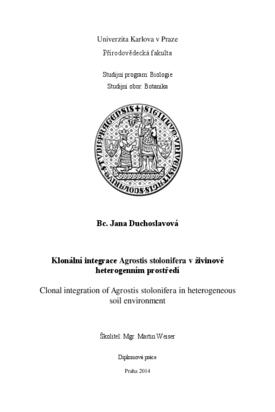Klonální integrace Agrostis stolonifera v živinově heterogenním prostředí
Clonal integration of Agrostis stolonifera in heterogeneous soil environment
diplomová práce (OBHÁJENO)

Zobrazit/
Trvalý odkaz
http://hdl.handle.net/20.500.11956/68455Identifikátory
SIS: 130962
Katalog UK: 990018561210106986
Kolekce
- Kvalifikační práce [21488]
Autor
Vedoucí práce
Oponent práce
Klimešová, Jitka
Fakulta / součást
Přírodovědecká fakulta
Obor
Botanika
Katedra / ústav / klinika
Katedra botaniky
Datum obhajoby
5. 9. 2014
Nakladatel
Univerzita Karlova, Přírodovědecká fakultaJazyk
Čeština
Známka
Výborně
Klíčová slova (česky)
klonální rostliny, fyziologická integrace, Agrostis stolonifera, heterogenita prostředí, živiny, sdílení zdrojů, dělba práce, foraging, morfologická plasticita, root-shoot ratioKlíčová slova (anglicky)
clonal plants, physiological integration, Agrostis stolonifera, environmental heterogeneity, nutrients, resource sharing, division of labour, foraging, morphological plasticity, root-shoot ratioSdílení zdrojů mezi rametami umožňuje klonálním rostlinám vypořádat se s heterogenitou prostředí. Dosavadní studie ukázaly, že výhody klonální integrace rostou s velikostí kontrastu v dostupnosti zdrojů mezi rametami. Stejně velký kontrast ale rostliny pravděpodobně vnímají různě při různé celkové dostupnosti zdroje. Lze očekávat, že integrace bude mít větší dopad spíše při celkově nižší dostupnosti zdroje a vysokém kontrastu v dostupnosti zdroje mezi rametami (Caraco & Kelly 1991). Cílem této práce bylo ověřit tyto předpoklady u dvojic ramet Agrostis stolonifera, které byly pěstovány při různě velkém kontrastu v dostupnosti živin zasazeném do různě celkově bohatých podmínek. Experiment s dvojicemi stejně vývojově starých ramet ukázal celkově velmi slabý efekt integrace na růst ramet, nicméně integrace měla pozitivní efekt na přežívání ramet a ovlivňovala také poměr podzemní a nadzemní biomasy ramet. V experimentu, kde dvojice tvořily starší mateřské ramety a jejich dceřiné ramety, byl efekt integrace na růst dceřiných ramet výraznější. Velikost efektu integrace ale byla, navzdory předpokladům, vyšší při vyšší dostupnosti živin pro dceřiné ramety a klesala s rostoucím kontrastem mezi rametami. Spojené dceřiné ramety měly také vyšší poměr podzemní a nadzemní biomasy než nespojené ramety, což...
Clonal plants may be able to cope with spatial heterogeneity due to the physiological integration of ramets. Previous studies demonstrated that benefits of clonal integration increase with patch contrast between individual ramets. However, the same magnitude of contrast may be perceived differently in rich and poor environments. According to the theoretical work of Caraco and Kelly (1991), I expected these benefits to be the greatest in overall poor conditions and high between-patch contrast. To test this hypothesis, I conducted experiments with pairs of ramets of a stoloniferous grass, Agrostis stolonifera, grown in variously nutrient rich conditions. The experiment with pairs of ramet of similar developmental age showed only very weak effect of integration on growth of ramets, although integration significantly improved survival of ramets and also affected root-shoot ratio of ramets. Nevertheless, there were considerable benefits of integration in the experiment with developmentally older mother ramets and their daughter ramets. Contrary to the predictions, the benefits of integration were bigger in rich conditions and they decreased with increasing between-patch contrast. In addition, effect of integration on root-shoot ratio of ramets was opposite to the expected specialization for acquisition...
